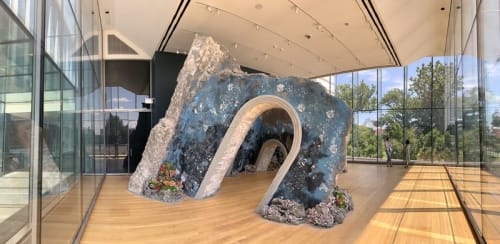
CLEVELAND, Ohio — Visitors to the quintet of exhibitions at the Cleveland Museum of Art organized as part of the FRONT International: Cleveland Triennial for Contemporary Art, are in for a delightful, thought-provoking shock.
Gallery 218, the so-called “Glass Box’' on the south end of the museum’s East Wing, normally hosts a collection of French 18th- and 19th-century sculptures. Now it has been transformed into something resembling a realization of Claude Debussy’s 1910 piano Prelude, “The Sunken Cathedral.”
The installation in the museum’s gallery isn’t specifically related to the Breton myth or the Debussy composition, but it certainly resonates with them.
The ruin appears to burst from the gallery floor like the cathedral of Ys, rising high toward the lofty ceiling, and disrupting the room’s placid, crystalline design.
The installation’s canted, faux-masonry walls introduce a note of funhouse distortion and disorientation, inviting visitors to crouch through diagonally-slanting arched doorways.
Firelei Báez (b. 1981, Dominican Republic), the vast ocean of all possibilities (19°36'16.9"N 72°13'07.0"W, 41°30'32.3"N 81°36'41.7"W), 2022. Mixed-media installation; dimensions variable. Courtesy the artist and James Cohan Gallery. © Firelei Báez.
There’s another deep cultural resonance here, to the 16th-century “Garden of Monsters’' in Bomarzo, Italy, about 75 minutes north of Rome. Attributed to architect Pirro Ligorio, the garden is filled with fantastic and grotesque creatures carved in stone, now covered in moss. It also includes a tilted, open-air palace with off-kilter rooms that induce dry-land seasickness because the floors inside are not in sync with the horizon outside.
Freedom underwater
Nadiah Rivera Fellah, the museum’s associate curator of contemporary art, who worked with Báez to realize the FRONT installation, said that instead of tapping into Debussy or the Garden of Monsters, the artist was motivated both by a desire to evoke the cataclysmic history of Haiti and French colonialism, along with another oceanic myth related to slavery, that of Drexciya.

A detail of the Firelei Baez installation at the Cleveland Museum of Art, part of the FRONT 2022 Triennial. Courtesy of Steven Litt for cleveland.com
Stenciled in turquoise and white with images of raised fists and broken chains, Báez’s palace walls signal defiance, and triumph, even as they appear to crumble and perhaps sink back into the sea.
The work’s complex imagery and numerous cultural echoes make it an ideal entry point for this year’s FRONT, dedicated to the idea that art can promote healing from traumas affecting individuals, communities, and entire societies.

